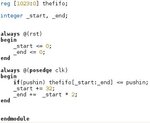keyboardcowboy
Member level 2
Is it possible to to do this in any way in verilog
1. Define a 1024 bit reg
2: fill this reg using another 32-bit reg which varies
for example
in other words
variable data slicing
1. Define a 1024 bit reg
Code:
reg [1023:0] ABC;2: fill this reg using another 32-bit reg which varies
for example
Code:
ABC[31:0] = input;
ABC[64:32] = input2;in other words
Code:
ABC[variable:variable] = input;variable data slicing

